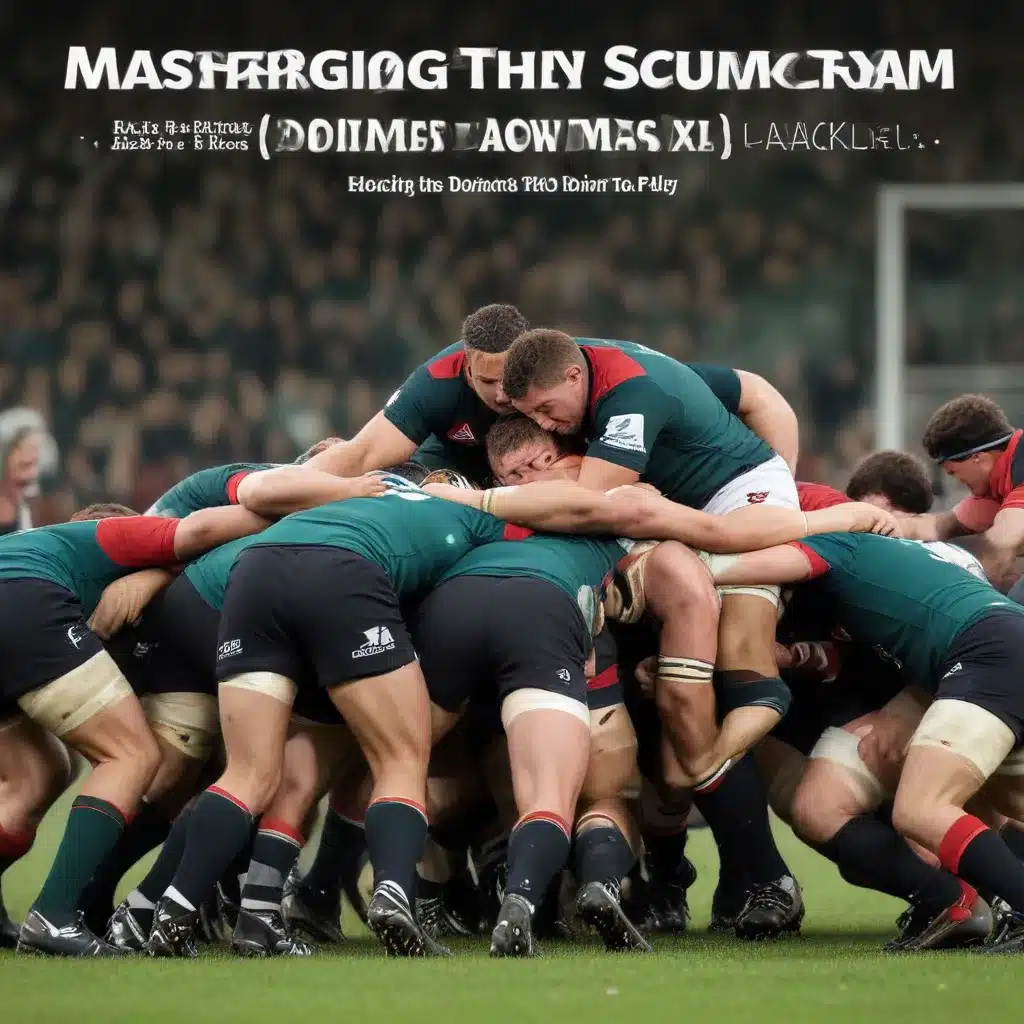
Mastering the Rugby Scrum: Unlocking the Key to Dominant Pack Play
The Foundations of Scrum Dominance
As a seasoned rugby professional, I’ve had the privilege of witnessing the evolution of the game’s most captivating set-piece: the scrum. This dynamic contest, where two packs of forwards engage in a ferocious battle for possession, is the foundation upon which dominant pack play is built. Mastering the art of the scrum is not merely a physical endeavor; it’s a symphony of technique, strategy, and unwavering determination.
At the heart of the scrum lies the intricate formation and the distinct roles played by each forward. The front row, comprising the loosehead prop, the hooker, and the tighthead prop, forms the pillars of the scrum. These players must possess exceptional strength, stability, and the ability to work seamlessly as a cohesive unit. As noted in the source from “the front row forwards, comprising the loosehead and tighthead props, form the pillars of the scrum. These front row rugby players will need to possess exceptional strength in their necks, shoulders, upper bodies, and legs, because they serve as the foundation of the scrum, preventing it from moving backwards, while also supporting the hooker.”
The hooker, positioned between the two props, assumes a pivotal role in coordinating the timing and precision of the scrum. Their ability to accurately hook the ball back through the props’ legs can be the difference between securing possession or ceding it to the opposition. As the source mentioned, “the hooker assumes a pivotal decision-making role within the forward line. Positioned between the two props in the scrum, the hooker coordinates the timing and strives to win possession by hooking the ball back through the props’ legs.”
Flanking the front row are the second-row forwards, or locks, whose tall stature, power, and technical proficiency are essential for winning lineout possession and providing stability in the scrum. These players have evolved to contribute more in open play, as the source highlights: “In recent times, second row rugby union players have evolved into ball carriers during open play, contributing to both support play and tackling.”
Completing the forward pack are the flankers and the number eight, who bring their own unique blend of skills and responsibilities. The flankers, with their exceptional all-around abilities, are instrumental in the scrum, lineouts, rucks, and mauls, while the number eight specializes in support play, tackling, and ball-carrying.
Scrum Engagement Strategies: Timing, Technique, and Cohesion
The scrum engagement is where the battle for dominance truly begins. As the teams crouch, bind, and prepare for the ‘set’ call, the true test of their scrum mastery is revealed. Timing is of the essence, as the source emphasizes: “The timing of the ‘set’ call and the engagement is critical. Teams often practice their scrum timing to perfection, as a well-coordinated push can catch the opposition off guard.”
Proper body positioning is paramount, with players maintaining a low, powerful stance to maximize their leverage and driving force. As the source states, “Maintaining a low and powerful body position is crucial. Players must engage their leg and core muscles to drive forward effectively. The front row, in particular, needs to stay as low as possible to maximize their leverage.”
Binding technique is another critical element, as the cohesion and stability of the pack depend on how tightly the players are connected. As the source notes, “Proper binding among teammates is essential for stability and strength in the scrum. The front row must bind tightly together, ensuring there are no gaps for the opposition to exploit.”
Tactical Masterstrokes: Scrum Variation and Adaptability
The scrum is not merely a brute force contest; it’s a chess match where strategy and adaptability reign supreme. Teams employ various tactics to gain the upper hand, such as “wheeling the scrum” to disrupt the opposition’s push or “splitting the scrum” to create opportunities for a steal.
As the game evolves, so too must the approach to scrummaging. The source highlights the importance of versatility: “Teams often have specialized scrummaging units within their forward packs. These units consist of players who excel in the scrum and are chosen for their ability to dominate in this area.”
Scrum coaches play a crucial role in this process, working tirelessly with the forwards to refine their techniques and strategies. Video analysis has also become a valuable tool, as teams study their own and their opponents’ scrums to identify weaknesses and opportunities for improvement.
Cultivating a Dominant Rugby Pack
Winning the scrum battle is not just about individual skills; it’s about the collective power and cohesion of the forward pack. As the source emphasizes, “Ultimately, winning the scrum is a collective effort that involves the entire forward pack working in unison.”
Pack communication, coordination, and a shared understanding of their roles are paramount. When the forward unit operates as a well-oiled machine, their ability to dominate the scrum and establish control of the game becomes unparalleled.
Alongside technical proficiency, the physical conditioning of the pack is equally important. Strength, power, and endurance are the cornerstones of scrum dominance, and a comprehensive training regimen tailored to the forwards’ needs is essential.
Unlocking the Secrets of Scrum Mastery
Mastering the rugby scrum is a lifelong pursuit, one that requires a deep understanding of the game’s mechanics, a relentless dedication to improvement, and a unwavering competitive spirit. By embracing the techniques, strategies, and tactics explored in this article, you can unlock the secrets to dominant pack play and lead your team to victory.
Remember, the scrum is not merely a clash of brute force; it’s a testament to the unity, discipline, and adaptability of the forward pack. Embrace the challenge, continue to refine your skills, and let your scrum dominance echo through the annals of rugby history. The Aberdeenshire RFC community stands ready to support you on your journey to scrum mastery.
